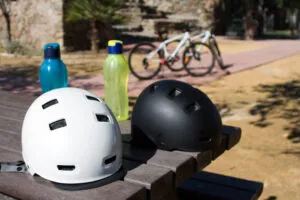
California’s helmet laws are designed to save lives. Just as we advise all drivers to avoid driving under the influence, we strongly recommend that all motorcyclists, bicyclists, and their passengers adhere to California’s helmet regulations.
We often hear the devastating consequences of not wearing a helmet from our network of Los Angeles DUI lawyers. It’s an easily avoidable tragedy. Understanding and following California’s helmet laws can protect your life and keep you out of legal trouble from the police. Here’s what you need to know about them.
Why Helmet Law Compliance Matters
According to the National Highway Traffic Safety Administration, helmets are about 37% effective in preventing motorcycle fatalities and about 67% effective in preventing brain injuries. For bicyclists, helmets can reduce the risk of head injury by up to 60%. Those are odds you can’t afford to ignore.
More riders wearing helmets reduces the overall burden on our healthcare system and emergency services. Serious head injuries often require extensive medical treatment, rehabilitation, and long-term care, all of which come at a significant cost to both individuals and society.
Complying with helmet laws sets a positive example for others, especially younger riders. Children and teenagers often emulate the behavior of adults around them. When they see motorcyclists and adult cyclists consistently wearing helmets, they’re likely to do the same.
Who Must Wear a Helmet in California?
Under California Vehicle Code Section 27803, all motorcycle riders and passengers must wear a helmet when operating or riding on a motorcycle, motor-driven cycle, or motorized bicycle. This law applies regardless of age or experience level. You must protect your head while riding.
California law also requires all bicycle riders and passengers under 18 to wear helmets. This regulation is outlined in California Vehicle Code Section 21212. While adults are not legally required to wear helmets on bicycles, we strongly recommend that all cyclists use proper head protection regardless of age.
Some local jurisdictions in California have enacted stricter bicycle helmet laws. If you’re cycling in an unfamiliar area, it’s wise to check local regulations to ensure compliance. For safety, it’s better to wear a helmet even if you’re not legally required to.
Penalties for Violating Helmet Laws
While not wearing a helmet puts you at risk of life-threatening head injuries, there are also legal consequences. If you’re caught riding without a helmet or wearing a non-compliant helmet as a motorcyclist, you could face:
- Fines
- Points on your driving record
- Increased insurance premiums
Moreover, in the event of an accident, not wearing a helmet could affect your ability to recover damages in a personal injury lawsuit. Not wearing a helmet makes you partially at fault for any head injuries.
Bicyclists may also face fines for not wearing a helmet, though they will be much less than motorcycle riders’ fines. Since helmet laws for cyclists apply to minors, parents or guardians could also face legal consequences if they knowingly let their child ride without a helmet.
Helmet Laws and DUI: a Dangerous Combination
As DUI defense attorneys, we’ve seen how poor choices can compound. Riding a motorcycle under the influence is not only illegal but extremely dangerous. Combine this with not wearing a helmet, and you’re putting yourself at severe risk.
A DUI conviction for motorcyclists carries the same heavy penalties as for car drivers, including:
- Loss of your California drivers’ license
- Fines and fees
- Potential jail time
- Mandatory DUI education programs
What Makes a Helmet Legal?
To comply with California regulations, Motorcycle helmets must meet the Federal Motor Vehicle Safety Standard (FMVSS) 218. These helmets are commonly known as DOT-compliant helmets. Key features include:
- A thick inner liner
- Sturdy chin straps
- Proper weight (about three pounds)
- No protruding objects extending more than two-tenths of an inch from the surface
Bicycle helmets in California must comply with the standards set by the U.S. Consumer Product Safety Commission (CPSC). A legal bicycle helmet should have:
- A sturdy shell to distribute impact force
- A layer of impact-absorbing foam lining
- Strong, adjustable straps to keep the helmet secure
- A sticker inside indicating CPSC compliance
Bicycle helmets are designed for single-impact protection. If you’ve been in an accident or the helmet has sustained a significant impact, it should be replaced, even if there’s no visible damage.
Stay Safe, Stay Legal
Helmet laws work. California passed motorcycle helmet laws in 1992, and the effect was immediate. In just one year, the number of motorcycle deaths reported in California dropped by 37.5%.
By understanding and following California’s helmet laws, you’re not just avoiding legal trouble but potentially saving your own life. Always wear a proper helmet and never ride under the influence.
If you need to find a lawyer and you live in the Los Angeles area, contact Los Angeles DUI Attorney to get connected with one in your area.



